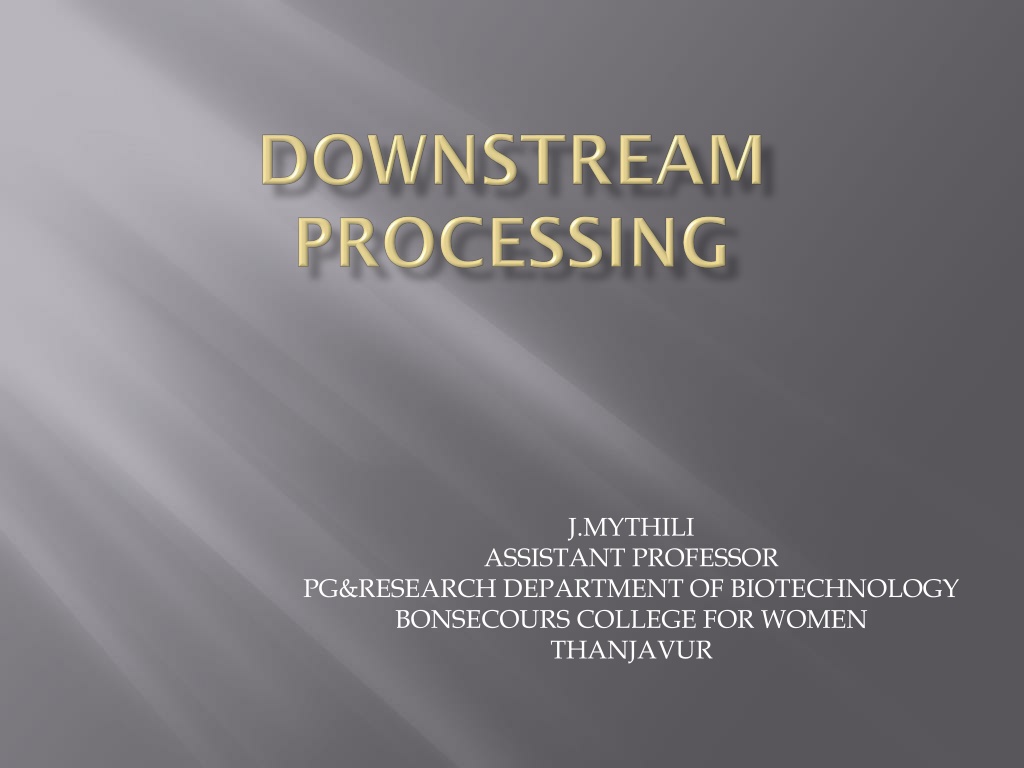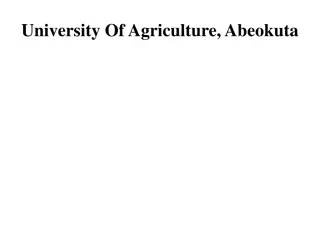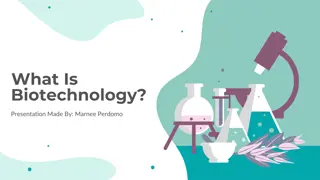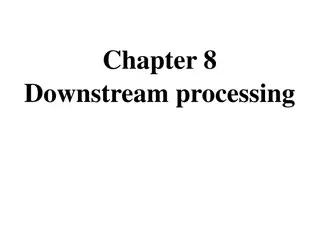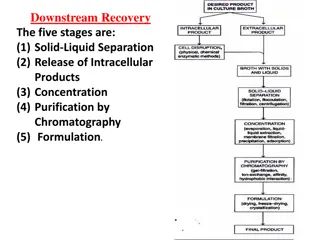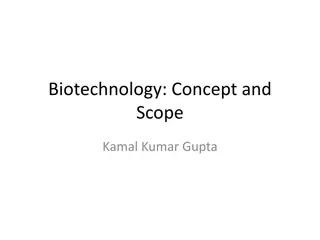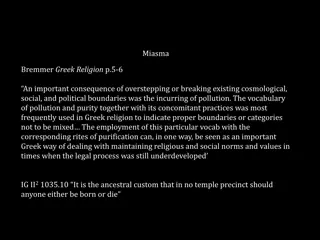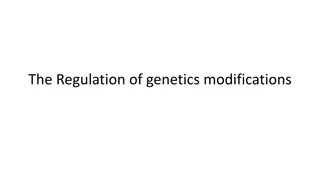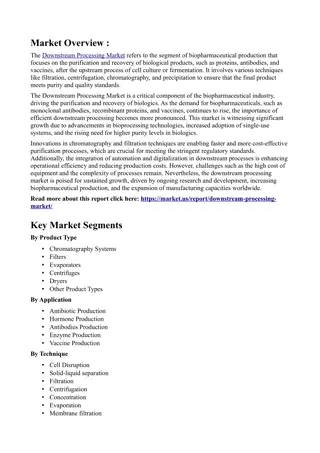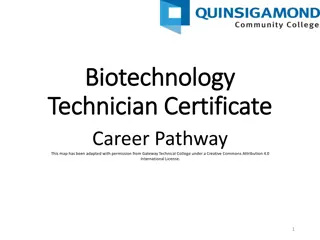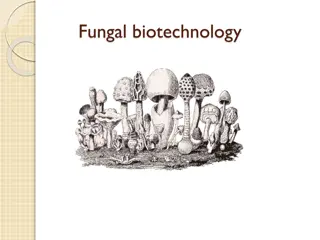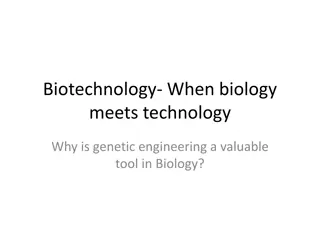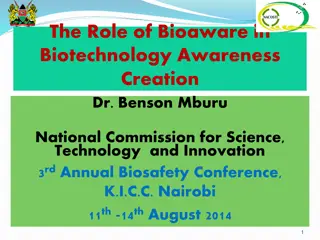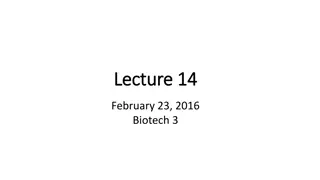Exploring Downstream Processing in Biotechnology for Product Recovery and Purification
Downstream processing in biotechnology involves the recovery and purification of biosynthetic products like pharmaceuticals from natural sources, using techniques such as filtration, centrifugation, and flocculation. This process is crucial in manufacturing antibiotics, hormones, antibodies, vaccines, industrial enzymes, and fragrance compounds. Separation methods like filtration and centrifugation are commonly used to isolate and purify products, with a focus on maximizing product yield and quality while minimizing costs and waste.
Download Presentation

Please find below an Image/Link to download the presentation.
The content on the website is provided AS IS for your information and personal use only. It may not be sold, licensed, or shared on other websites without obtaining consent from the author. Download presentation by click this link. If you encounter any issues during the download, it is possible that the publisher has removed the file from their server.
E N D
Presentation Transcript
J.MYTHILI ASSISTANT PROFESSOR PG&RESEARCH DEPARTMENT OF BIOTECHNOLOGY BONSECOURS COLLEGE FOR WOMEN THANJAVUR
Downstream processing refers to the recovery and purification of biosynthetic products, particularly pharmaceuticals, from natural sources such as animal or plant tissue or fermentation broth, including the recycling of salvageable components and the proper treatment and disposal of waste. It is an essential step in the manufacture of pharmaceuticals such as antibiotics, hormones (e.g. insulin and humans growth hormone), antibodies (e.g. infliximab and abciximab) and vaccines; antibodies and enzymes used in diagnostics; industrial enzymes; and natural fragrance and flavor compounds. Filtration is the most commonly used technique.
Removable of Insolubles. Product isolation Product purification Product polishing A few product recovery methods may be considered to combine two or more stages. For example, expanded bed adsorption accomplishes removal of Insolubles and product isolation in a single step. Affinity chromatography often isolates and purifies in a single step.
Separation of cells , cell debris and other particulate matter. Typical operation to achieve this: 1) Filtration 2)Centrifugation 3)Sedimentation 4)Flocculation a process solute comes out of solution in the form of floc and flakes. 5)Gravity settling
A mechanical operation used for the separation of solids from fluids(Liquid or gases)by interposing a medium to porous, membrane through which the fluid can pass, but the solids in the fluid are retained. The solid particles deposited on the filter form a layer, which is known as filter cake. All the solid particles from the feed are stopped by the cake,and the cake grows at the rate which particles are bought to its surface. All the fluid goes through the cake and filter medium.
It is one of the most Commonly used type of filter in fermentation. The drum is pre coated prior to filtration. The small agent coagulating is added to the broth before is pumped in to the filter. The drum rotates under vacuum and a thin layer of cells sticks to the drum. The thickness of the layer increases in the section designed for forming the cake. Points to be considered while selecting the filter medium: Ability to build the solid. Minimum resistance to flow the filtrate. Resistance to chemical attack. Minimum cost. Long life.
Centrifugation used to separate particles, of 100-0.1 micrometer from liquid by gravitational forces. It depends on particles size ,density diferrence between the cell and the broth and the broth viscosity. Use of the centrifugal force for the separation of mixtures. More-dense components migrate away from the axis of the centrifuge. Less-dense components migrate towards the axis. Types of centrifuges are ,tubular bowl centrifuge, multi champer centrifuge disc bowl centrifuge etc.
It is applicable only for large particles greater than 100 meter flocs It is slow process and takes 3 hours. It is used in process like activated sludge effluent treatment. It is free settling process depends only on gravity. Particle settling in a high particles(density suspension (hindered settling).
Process where a solute come out of a solution in the form of flocs or flakes. Particles finer than 0.1um in water remain continuously in motion due to electrostatic charge which causes them repel each other. Once electrostatic charge is neutralized (use of coagulant ) the finer particle start to colloid and combine together. These larger and heavier particles are called flocs.
Removable of those components whose properties vary markedly from that of the desired product . Water is the chief impurity. a) Isolation steps are designed to remove it (i.e. dialysis) b)Reducing the volume c)Concentrating the product d)Liquid-liquid Extraction, Adsorption, Ultra filteration, and precipitation and some of the unit operation involved.
Done to separate those contaminants that resemble the product very closely physical and chemical properties. Expensive to carry out. Require sensitive and sophisticated equipment. Significant fraction of the entire downstream processing expenditure. Example of operations include affinity ,size exclusion, reversed phase. Chromatography ,crystallization and fractional precipitation.
Separation of mixtures Passing a mixture dissolved in a mobile phase through a stationary phase, which separates analyte to be measured from other molecules to the mixture and allows it to be isolated.
Used charged stationary phase to separate charged compounds. Resin that carries charged functional groups which interact with oppositely charged groups of the compound to the retained. FPLC
Ion is an atom or molecule which has lost are gained one or more valence Electrons, giving it a positive or negative electrical charge. Anions are negatively charged ions ,When an atom gains electron in a reaction Anions are negatively charged because there are more electrons Associated with them then there are protons in their nuclei. Cations are positively charged ions ,formed when an atom electrons in a reaction, forming an electron hole .
Affinity chromatography separates the protein of interest on the basis of a reversible interaction between it and its antibody coupled to a chromatography bead (here labeled antigen) . With high selectivity, high resolution, and high capacity for the protein of interest, purification levels in the order of several thousand-fold are achievable. The protein of interest is collected in a purified, concentrated form. Biological interactions between the antigen and the protein of interest can result from electrostatic interactions, van der Waals' forces and/or hydrogen bonding. To elute the protein of interest from the affinity beads, the interaction can be reversed by changing the pH or ionic strength. The concentrating effect enables large volumes to be processed. The protein of interest can be purified from high levels of contaminating substances. Making antibodies to the protein of interest is expensive, so affinity chromatography is the least economical choice for production chromatography
Gel permeation/ filteration Chromatography(GPC) Separate molecules According to their size Low resolution polishing Tertiary/Quaternary structure(native)
Reversed phase chromatography is an elution procedure used in liquid chromatography in which the mobile phase significantly more polar than the stationary phase.
The dipole-dipole intermolecular forces between the slightly positively charged end. Of one molecule to the negative end of another of a same molecule. Molecular polarity dependent on the difference in electronegativity between atoms in a compound and the asymmetry of the compound s structure.
Mobile phase is a liquid. Carried out either in a column or a plane. HPLC. In the HPLC technique, the sample is forced through a column in packed irregularly spherically shaped particles or a porous monolithic layer(stationary phase) by a liquid (mobile phase)at a high pressure.
Process of formation solid crystals precipitating from a solution ,melt or more rarely deposited directly from a case. Chemical-sold liquid separation technique ,in which mass transfer of a solute from the liquid solution from the pure solid crystalline phase occurs.
End with packaging of the product in a form that is stable ,easily transportable and convenient. Crystallization Dessication Lyophilization Spray drying May include: Sterilization of the product Remove are deactivate trace contaminants which might compromise product safety viruses depyrogenation.
Freezing the material. Reducing the surrounding pressure and adding enough heat to allow the frozen water in the material to sublime directly from the solid phase to gas.
